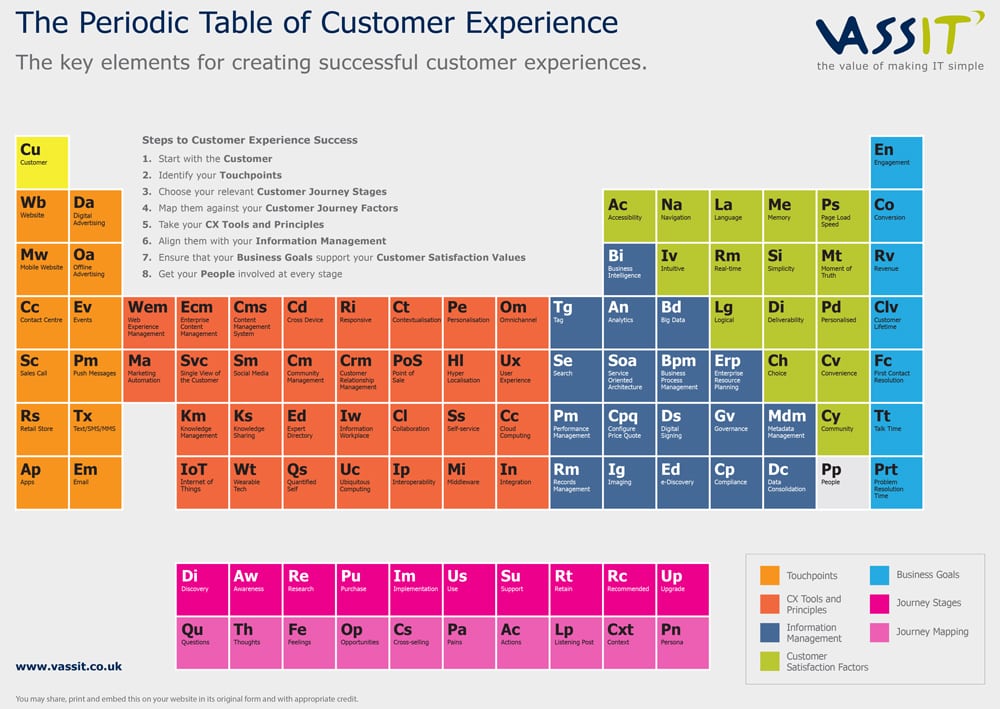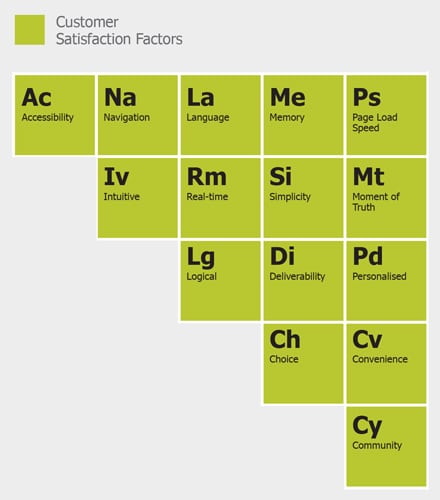If you’re a longtime reader of this blog, you may have noticed that we emphasize the importance of a seamless, personalized customer experience across all touch points.
Zeroing in on customer experience has a couple of benefits.
Research by HBR found that companies who successfully manage and execute customer experience strategies reap enormous rewards: reduced churn, increased revenue, stronger customer relationships, loyalty and greater employee satisfaction.
But how do you achieve a great customer experience?
Vassit, a UK-based Digital Transformation specialist, created The Periodic Table of Customer Experience. It’s intended to help businesses improve their understanding of how broad customer experience really is. The table contains several blocks, aligned like the Periodic Table of Elements, and defines several key elements to creating successful customer experiences.

In this article, we’re going to delve a little deeper into the 15 key elements that influence “customer satisfaction”.
Although customer experience and customer satisfaction are not exactly the same, they are intimately related:
1) The combination of a series of customer experiences influences overall the customer satisfaction and
2) Customer satisfaction scores can help you recognize whether you are delivering a truly seamless customer experience.
Both are essential for revenue growth.

1. Accessibility
You need to ensure that customers are able to find and access your products and services efficiently, without barriers and friction, on their preferred channel.
Also, make sure that they can reach your company and obtain good service whenever they have a question or need assistance to make a purchase decision.
2. Navigation
Navigating and browsing your store should be a straightforward and simple process. This includes providing users who know what they want with an effective keyword search or filters but also integrating solutions that guide unsure shoppers to help them identify suitable products quickly.
A website that’s difficult to navigate will only lead to customer frustration and a loss of potential customers.
3. Page Load Speed
It’s a simple rule: the faster your website loads, the happier your visitors. If one of your pages doesn’t appear lightning-fast, your customer will move on to speedier online stores. In fact, the Aberdeen Group found that,
“A 1-second delay in page load time equals 11% fewer page views, a 16% decrease in customer satisfaction, and 7% loss in conversions.”
According to a survey by Akamai and Gomez.com, 79% of web shoppers who experience a slow website say they would not return to the site to buy again and around 44% of them would tell a friend about the poor online shopping experience.
4. Language
Speaking to your customers in their preferred language is pivotal for your business. More than 50% of consumers won’t make a purchase if information about a product isn’t available in their language.
However, language doesn’t only apply to language in terms of geographical demographics but also how certain phrases or terms resonate with your audience and reflect back on your business. Use user-friendly language and avoid industry specific jargon that could cause confusion and rob you of an opportunity to connect on a personal level.
Without great communication, there can be no great customer experience.
5. Memory
According to Harvard Business Review, customers become frustrated if they have to repeat themselves. Consumers feel comfortable switching from one channel to another and expect their information and data to follow them along. They don’t want to be asked for the same details over and over again, regardless of the channel or department, they’re interacting with.
Memory also means remembering your customer’s needs and wants to avoid trying to sell products to customers, which they already have or clearly have no interest in.
6. Personalized
It’s kind of ironic that shoppers want personalized experiences in a sphere in which so many business and personal interactions can be anonymous.
By personalizing the experience and sharing the right content, at the right time with the right people, you can make interactions faster, easier and more efficient for your customers.
This results in increased customer satisfaction and the likelihood of repeat visits.
7. Convenience
Convenience is an essential element of a positive customer experience. It influences how customers make decisions about what to buy, what services to use, where to go, and with whom to engage.
It consists of 5 key variables
- Decision Convenience: How quickly and easily a customer can decide what to shop at your store?
- Access Convenience: How easily is your store is accessible?
- Benefit Convenience: What core benefits does a customer receive at your store like receiving great customer service?
- Transaction Convenience: How quickly can the customer complete the payment?
- Post-Benefit Convenience: How effectively are you handling post-purchase issues like replacements or return of products?
If the perceived convenience is low, your customer will see interacting with you as work. If they struggle to do business with you during any of the areas above, then they’re more likely to go elsewhere.
8. Intuition
Customers value companies that “really get them”. Some companies simply have a good intuition or “sixth sense”. They are proactive and anticipate the needs and emotions of customers. Companies who know what their customers want before they want it or solve a problem before customers even know it exists are able to create better, more convenient experiences and a trust-based relationship.
For example, Southwest Airlines has a team called Proactive Customer Service that works with 14 other departments to ensure operational efficiencies, effective communications, and better customer accommodations. Their job is to evaluate flight disruptions, determine the customer impact, and reach out to customers proactively so the customer doesn’t have to reach out to them.
9. Real-Time
If you want to capture the attention of your audience, think about how you can take advantage of real-time experiences. It’s about showing up when your customers need you. Real-time interactions are becoming increasingly important to the modern consumer. They expect real-time responses and faster resolutions.
For instance, “instant chat” and chatbots have emerged as a highly popular marketing solution for companies that want to provide their customers immediate access to information and show the more human and authentic side of their business.
10. Simplicity
Simplicity is key. It is one of the easiest ways to improve your chances of getting your customer’s business is by making the process as simple as possible. You need to take away the intricacy and complexity related to decision-making by advising and supporting customers throughout their journey.
“To keep your customers, keep it simple”
Harvard Business Review
A study of the Latin American life insurance market observed that 40% of people who purchased a life insurance policy and were happy about their experience said it was because of a simple buying process.
11. Logic
There is a difference between emotional customer satisfaction and logical customer satisfaction.
- Emotionally satisfied customers are extremely satisfied with the products and services the company provides and have a strong emotional attachment to the company.
- Logically (or rationally) satisfied customers may be extremely satisfied with the company but lack the strong emotional connection of customers who are emotionally satisfied. They essentially behave no differently than customers who are dissatisfied. They have no reason to remain loyal.
To convert logically satisfied customers into emotionally satisfied customers, you have to provide customers with logical reasons why they should do business with you over your competitors. This means understanding their expectations to meet or even exceed them.
12. Deliverability
According to an Econsultancy report, 48% of customers are not willing to wait more than five days for most of their purchases, while 23% said they would be willing to wait eight days or more.
Shipping time does not only influence purchase decisions but also has a major impact on customer satisfaction.
13. Choice
The more choices you can give your customers during the buying process, the more likely they are to feel in control of the experience that they have with your brand.
However, when offering choices make sure to support your customers and enable them to figure out the optimal choice that is right for them.
Choice overload and the Paradox of choice are very real in today’s environment and are a growing concern for retailers and brands.
14. Community
Today, customers are doing more and more research online before they make a purchase. It’s important to consider the community that exists around your brand. Even if you don’t have an active part in building your community, one will form around your business – on social media, websites, and review forums.
The best way to take charge of your brand reputation is to make sure that you engage with your community whenever possible. Even when someone has something bad to say about your business, learn how to respond from a positive perspective, by offering a solution to a problem.
15. Moment of Truth
Finally, the “moment of truth”. It defines the make-or-break moments in the customer journey, that influence whether the customer will continue the journey, complete the task or interaction and continue to business with you. If things go awry during these specific moments, consumers will not complete the interaction and will go elsewhere.
By identifying the moments of truth in the customer journey, you’ll be able to focus on optimizing the interactions that truly impact the customer experience and customer actions.
“A customer can have lots of questions, issues and transactions, but there may be only a few that really make a difference in whether they will buy from you again or recommend you. What issue, transaction or touchpoint has the greatest impact on the customer’s willingness to buy again and their willingness to recommend you? That becomes the defining moment.”
Cynthia Grimm, Chief Customer Experience Officer, CX Solutions
Image by Jason Hargrove

